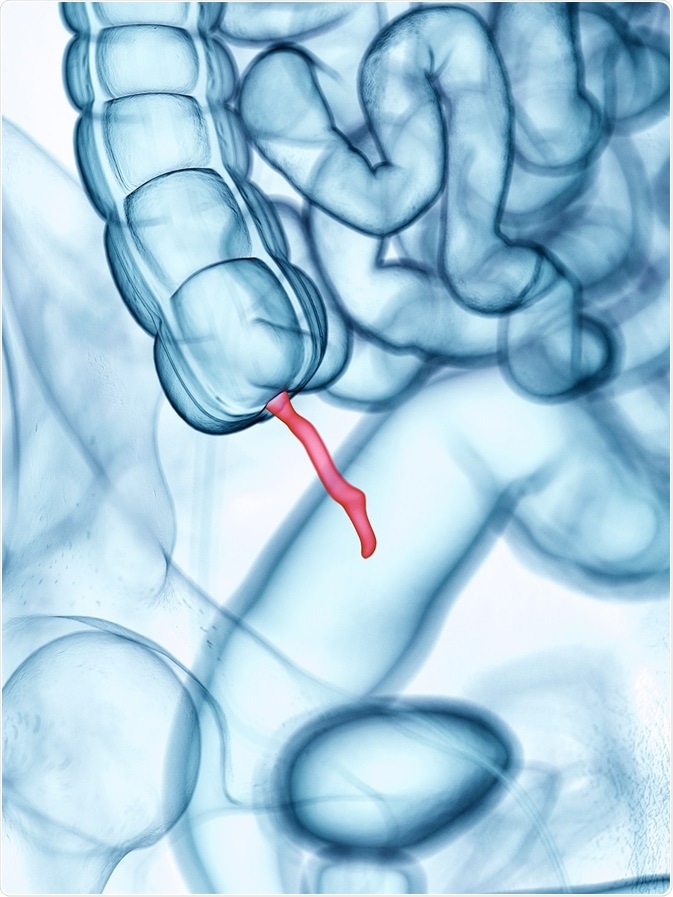By Jeyashree Sundaram, MBA
Pseudomyxoma peritonei (PMP) typically starts as a slow-growing tumor in the appendix, and it is hence classified as a low-grade mucinous appendiceal neoplasm (LAMN). In rare instances, it may develop in other organs, such as the ovary, bowel, or bladder.

Credit: Sebastian Kaulitzki/ Shutterstock.com
PMP is an uncommon disease characterized by the accumulation of mucinous ascites within the peritoneal cavity. As the mucin develops in the lining of the tummy, it results in the compression of the bowel and other intestinal organs. It affects women more than men, with a ratio of 9:1.
Symptoms
PMP symptoms typically take a long time to appear, and some patients may not exhibit any symptoms for several years. As a result, this deadly disease can be challenging to diagnose. The symptoms include:
Abnormality of the abdomen, the abdominal wall, and the peritoneum:
- Swelling of the abdomen
- Abdominal pain
- Irritation
- Redness
Increased size of the abdomen is the main symptom associated with PMP, which occurs because of conditions such as neoplasm, ascites, or renal abnormality. As the tumor grows larger, the abnormal growth leads to the enlargement of either the entire abdomen or specific regions within it.
The surface of the peritoneum—a set of tissues that lines the abdominal wall and surrounds the inner organs of the abdomen—consists of a liquid called peritoneal fluid. This fluid facilitates the smooth movement of tissues.
The amount of peritoneal fluid increases gradually as the tumor grows. This condition is known as ascites. It can also lead to increased abdominal girth. The increased liquid may then compress internal organs, such as reproductive organs, digestive organs, and organs of the urinary, biliary, or gastrointestinal systems. Abdominal pain may result from this. Inflammation of the large intestine is typically accompanied by redness, protrusion, and pain in the affected area.
Hernia
A hernia occurs when a structure or part of an internal organ or tissue protrudes through a weak area, such as a bone, a membrane, or muscular tissue. It is primarily acquired in the abdomen and can be internal or external. Hernia is a commonly occurring condition and can affect any individual, including women, men, and children.
Constipation
Defecation difficulties or blockage that leads to swelling or pain in the abdomen is another symptom of pseudomyxoma peritonei.
Nausea and vomiting
Nausea and vomiting may be symptoms of many medical conditions. Both symptoms are related, but each one may occur separately. In PMP, these symptoms arise due to gastrointestinal disorders such as infectious gastroenteritis. It can also cause loss of appetite.
Respiratory insufficiency
Difficulty in breathing may occur due to the compression of internal organs, such as the lungs.
Loss of weight
Losing weight can be a symptom of various disorders. However, in people affected by PMP, it may occur gradually, with the development of mucin inside the abdomen, which can lead to poor food intake and malnutrition. It results in a lack of proper nutrition.
Infertility
Infertility can arise because of many clinical conditions, PMP being one of them. If any unexplored symptoms occur, they must be verified by consulting a doctor.
Causes of PMP
The exact cause of PMP remains unknown. Hereditary, family, or ecological factors have not been associated with an increased risk of this cancer. Several distinct factors contribute to the development of most cancers. A variety of tumors can lead to PMP. However, it is accepted that the site of origin of PMP is the appendix.
It is believed that the tumor cells from the affected appendix migrate to areas within the abdominal cavity and pelvis. The leaked tumor cells proceed to grow and produce mucinous ascites, which are dispersed throughout the abdomen.
Aggregation of mucin in the abdomen can lead to an increase in the size of the latter. The profile of PMP is typically identified by expanding the abdominal circumference. It is ultimately confirmed by the presence of mucus in the abdominal cavity (also known as a "jelly belly").
Causes of PMP can be explained using several theories. From the patients’ medical records, specialists and researchers have identified other possible sites from which PMP can originate, which may include the urachus, stomach, colon, ovary, pancreas, and other organs of the digestive system.
Risk factors
In retrospective studies, the most common attribute seen was age. It is likely to occur in individuals aged 59 and above. A pre-existing neoplasm, either benign or malignant, in the appendix that is still alive and continues to develop in the abdomen, can cause PMP.
A benign tumor is non-cancerous because it grows in a specific region and does not spread easily, whereas malignant tumors are cancerous. People with a pre-existing neoplasm (malignant stage) are at a higher risk of adverse outcomes.
Further Reading
Last Updated: Jun 29, 2025